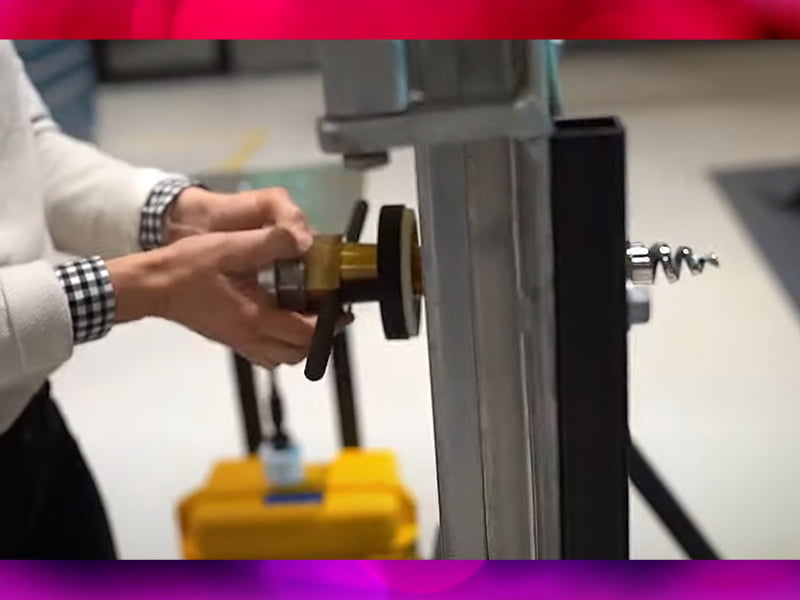Sydney-based maritime firefighters Sarah Battenally and James Manderson wanted to make a profound change to firefighting technology, and embarked on a mission to design a simple, safe, portable penetration device and methodology for fighting compartment fires at sea.
The Breach and Attack Tool (BAT) they developed is lifesaving. It extinguishes fires at sea in an environment where immediate help is not available, says Sarah Battenally, who is a co-founder and director of Manderson Engineering Innovations (me-innovations) alongside Mr Manderson.
The company is a finalist in the 2022 InnovationAus Awards for Excellence in the Defence category. The winners will be announced at a special black-tie gala to be held on November 17 at The Cutaway venue at Barangaroo in Sydney. You can book your seats here.
The BAT and its accompanying Deck Box (an access facilitation conduit) provides mariners with a low-cost detection system for fire or explosions and a new, safe, effective indirect suppression capability.

“Through our experience, myself a 12-year mechanical fitter studying undergraduate engineering, and James, a wonderfully talented boilermaker and fabricator of 15 years, we have designed and developed innovative technologies that will change firefighting at sea,” Ms Battenally said.
BAT suppresses out-of-control compartment fires at sea and ashore for compartments that have taken damage or are not fitted with adequate fire suppression systems, providing more versatile firefighting options to save lives, ships and bolster naval lethality.
“By penetrating the BAT through the Deck Box, the system is self-locking, gastight and can be operated unmanned, removing personnel from the vicinity of danger. It’s a needed solution to assist in narrowing gaps in current indirect attack and fire safety procedures.”
In fact, installing the Deck Box into a vessel’s structure provides firefighters with an ideally located and pre-set penetration mechanism, thereby removing exothermic hull cutting or drilling operations to access the fire, Ms Battenally explained.
What’s more, the invention circumnavigates any need for personnel to make a direct attack in untenable compartment fires. The goal is to fill the gaps in prevalent seagoing and survivability operations.
“The method of fitting the BAT takes only seconds to perform and provides mariners and firefighters with a mutual aid asset in coordinating a more effective indirect fire attack.”
For the first time, instead of using prevalent naval containment methods – such as using either existing holes or cutting holes to access fire – this system can penetrate into the fire with a gas tight fitting, Ms Battenally said.
“The system protects against extreme fire behaviour such as flashover, backdraft and fire gas ignition.
With the rate that maritime and naval technologies are evolving, it’s important that damage control and firefighting safety systems also need room to evolve, Ms Battenally said.
“We consider the challenge here is that current technology and procedures cannot adequately regain control of compartment fires or explosions, and we have a product that can do just that.”
Modernising fire safety
Coming from deep warfighting and maritime firefighting experience – and a shared work history serving at sea – the two innovators set themselves a mission: To advocate the modernisation of fire safety preparedness across the naval, maritime, and Australian emergency services.
“While serving at sea in 2018, James was my ship’s fire and emergency party leader. He would inspire me with his passion and ideas for modernised naval damage control and firefighting tools. He noticed a need for all mariners to have a greater posture in the containment phase of a fully developed compartment fire.
“We are two homegrown maritime firefighters with more than 25 collective years of naval service, shipborne survivability and firefighting experience in the marine and industrial environments.
Future vision
A company goal is to secure a Defence Innovation Hub (DIH) contract to supply its technology to the Royal Australian Navy.
“We’re a young company of two innovators just starting our DIH application journey, and we understand it may take a long time to realise and possibly longer to implement.
“However, we trust it will be an incredible learning experience and the best path to contribute to our peers in the Navy. It also provides confidence that we can work with the Office of Defence Industry Support and commercial bodies and continue to serve.”
Currently, the company has received a clear International Preliminary Report on Patentability (IPRP) on its Patent Cooperation Treaty (PCT) application. It also has patents pending on other supporting equipment and designs.
“As for the future, we look forward to potentially becoming a Defence manufacturer and supplier and aspire to the possibility of becoming an exporter to our allied navies and fire safety industries.”
Do you know more? Contact James Riley via Email.
